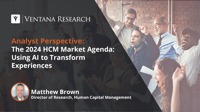The topic of skills is not new to the world of talent management or development, making many appearances in the talent conversation over the years. Recently, it has been a permanent fixture in the discussion, focusing on the total integration of skills across all aspects of the employee experience. The term “skills economy” describes the evolution of how value is assigned in the workplace and employment, emphasizing the importance of individual skills over traditional job credentials.
Read More
Topics:
Human Capital Management,
Learning Management,
Talent Management,
Workforce Management,
Payroll Management,
Total Compensation Management,
employee experience
Ventana Research recently announced its 2024 Market Agenda for Human Capital Management, continuing the guidance we have offered for two decades to help enterprises derive maximum potential from workforce- and people-related technology investments and initiatives. In crafting this Market Agenda, we focused on essential themes that are critical for HR organizations and for the software providers supporting them. The transformative nature of AI has not just begun to bring intelligence to HCM; it...
Read More
Topics:
Human Capital Management,
Learning Management,
Talent Management,
Workforce Management,
Payroll Management,
Total Compensation Management,
employee experience
When my father entered the workforce in the 1950s, his path was relatively clear. He graduated high school, went to work in his chosen trade, did a stint in the Navy Reserves, and continued in the same or adjacent career until he retired. The same was true for my uncle, who chose to go to college but joined a firm working in his field, worked hard to be promoted, and changed companies one time before retiring as an executive. But the nature of work and job-hunting has undergone a radical...
Read More
Topics:
Human Capital Management,
Talent Management
In recent years, the corporate landscape has witnessed a notable shift towards prioritizing employee experience. Organizations have recognized that a content and engaged workforce translates to higher productivity, reduced turnover and improved profitability, as I previously wrote about. Consequently, companies have invested considerable resources in creating a positive work environment and enhancing the overall experience of their employees. While this emphasis on employee experience is...
Read More
Topics:
Human Capital Management,
Recruiting,
Talent Management,
employee experience,
Talent Acquisition,
Candidate Experience
Talent acquisition remains a focal point for most organizations in this dynamic and highly competitive corporate environment. Unfortunately, the pivotal process of offboarding often takes a back seat. An efficient employment separation process plays a key role in enhancing the employee experience, protecting the company's reputation and mitigating potential legal and financial risks associated with employee separation. One solution that effectively addresses these complexities is Onwards HR, a...
Read More
Topics:
Human Capital Management,
Talent Management
For decades, most organizations thought of onboarding as a basic housekeeping item, akin to filling out tax withholding paperwork, having a picture taken for a badge, getting a uniform or signing for a handbook. In reality, true onboarding encompasses much more. It’s considerably more strategic than tactical, including all processes required to successfully integrate a new employee into an organization.
Read More
Topics:
Human Capital Management,
Talent Management,
employee experience
Perhaps no human capital management-related topic has been more widely examined in recent years than the struggle to find and retain top talent. Software has flooded the market to address the challenge from every angle — automated sourcing and stack ranking of candidates; artificial intelligence-powered employee sentiment analysis for identifying and reducing the risk of attrition; and internal skills gap identification with connected learning opportunities to help organizations quantify what...
Read More
Topics:
Human Capital Management,
Talent Management
Organizations are constantly striving for agility and efficiency to stay competitive. From a human-capital standpoint, a logical way to achieve this is by moving away from a job title and education-based workforce and transitioning to one that is skills-based. This approach emphasizes the skills and capabilities of individuals rather than their prior job titles or education, enabling organizations to tap into a broader talent pool and adapt to changing business needs. However, creating a...
Read More
Topics:
Human Capital Management,
Talent Management
In recent years, organizations have struggled to find and retain the right talent to fill critical roles. This can be attributed to a combination of factors, including an aging workforce, a lack of critical skills needed for current and future organizational needs, and increased competition for talent from other organizations seeking similar skills. Our research shows that, within the next five years, one-half of all employees will require significant reskilling and upskilling in order to keep...
Read More
Topics:
Human Capital Management,
Talent Management
A decade ago, organizations were sold on best-of-breed technology stacks. In the world of human capital management, that meant a separate system for each of the myriad processes that make up a worker's life span with a company. The approach seemed to make sense because a single system cannot be the best at everything, can it? Is it realistic for a single provider to create the most advanced applicant tracking, onboarding, learning, payroll, compensation, performance management, succession...
Read More
Topics:
Human Capital Management,
Talent Management,
employee experience


















